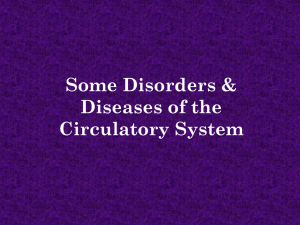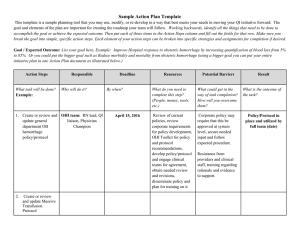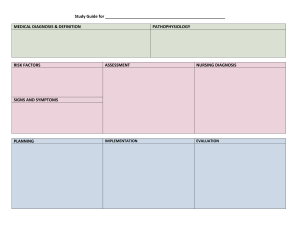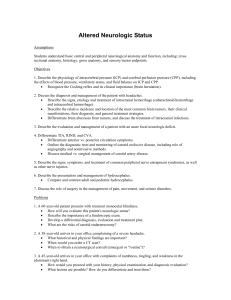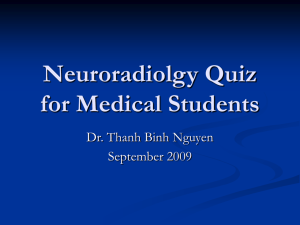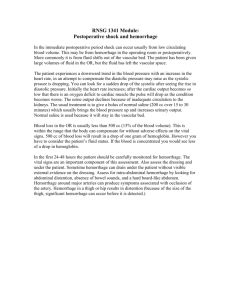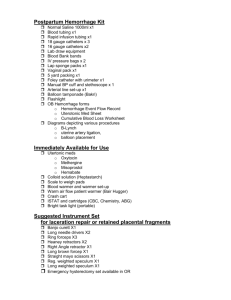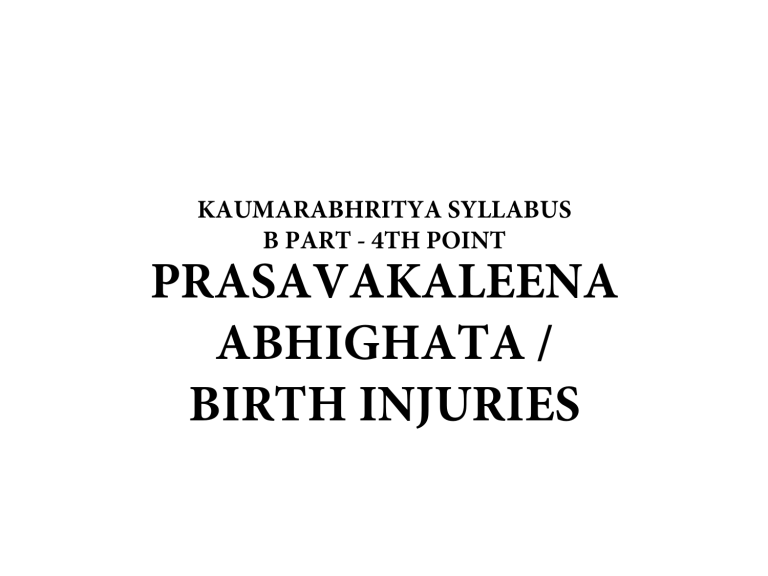
KAUMARABHRITYA SYLLABUS B PART - 4TH POINT PRASAVAKALEENA ABHIGHATA / BIRTH INJURIES DEFINITION • An impairment of the infants body function or structure due to adverse influences that occur at birth • (National vital statistics report) RISK FACTORS • • • • • • Primiparity Small maternal stature Maternal pelvic anomalies Prolonged or unusually rapid labor Oligohydramnios Malpresentation of the fetus • Use of mid forceps or vaccum extraction • Versions and extractions • Very low birth weight or extreme prematurity • Fetal macrosomia or large fetal head • Fetal anomalies TYPES • Head and neck injuries • Nerve injury • Facial injuries • Fractures • Intra-abdominal injury • Soft tissue injuries HEAD AND NECK INJURIES EXTRACRANIAL INJURIES • CAPUT SUCCEDANEUM • CEPHALHEMATOMA • SUBGALEAL HEMORRHAGE CAPUT SUCCEDANEUM • A caput succedaneum is a serosanguinous fluid collection above the periosteum. It presents as a soft tissue swelling with purpura and ecchymosis over the presenting portion of the scalp. It may extend across the midline and across suture lines. • The edema disappears within the 1st few days of life. • Molding of the head and overriding of the parietal bones disappear during the 1st weeks of life. • Rarely, a hemorrhagic caput may result in shock and require blood transfusion. MANAGEMENT • No specific treatment is needed • But if extensive ecchymoses are present, hyperbilirubinemia may develop • Shock – Blood transfusion CEPHALHEMATOMA • A cephalhematoma is a subperiosteal blood collection caused by rupture of vessels beneath the periosteum. Clinical features • Swelling, usually over a parietal or occipital bone • Swelling does not cross a suture line and is often not associated with discoloration of the overlying scalp. • Limited to the surface of one cranial bone. Diagnosis • Physical examination • Skull radiograph • cranial computed tomography • If infection is suspected, aspiration of the mass • If sepsis, antibiotics • hyperbilirubinemia – photo therapy SUBGALEAL HEMORRHAGE • A subgaleal hemorrhage is bleeding between the galea aponeurosis of the scalp and the periosteum. FEATURES • A subgaleal hemorrhage presents as a firm-to-fluctuant mass that crosses suture lines. • The mass is typically noted within 4 hours of birth. LABORATORY FINDINGS • serial hemoglobin and hematocrit monitoring, • coagulation profile to investigate for the presence of a coagulopathy. • Bilirubin levels also need to be monitored TREATMENT • Supportive • Transfusions may be required if blood loss is significant. • In severe cases, surgery may be required to cauterize the bleeding vessels. • These lesions typically resolve over a 2–3 week period CRANIAL INJURIES • LINEAR SKULL FRACTURES • DEPRESSED SKULL FRACTURES LINEAR SKULL FRACTURES • Usually affect the parietal bones. • The pathogenesis is related to compression from the application of forceps, or from the skull pushing against the maternal symphysis or ischeal spines. • Rarely, a linear fracture may be associated with a dural tear, with subsequent development of a leptomeningeal cyst. DEPRESSED SKULL FRACTURES • Indications for surgery include • radiographic evidence of bone fragments in the cerebrum • presence of neurologic deficits • signs of increased intracranial pressure • signs of cerebrospinal fluid beneath the galea • failure to respond to closed manipulation. • Indications for nonsurgical management include • Depressions less than 2 cm in width and depressions over a major venous sinus • Without neurologic symptoms INTRACRANIAL INJURY • • • • • • Intracranial haemorrhage Epidural hemorrhage Subdural hemorrhage Subarachnoid hemorrhage Intraparenchymal haemorrhage Germinal matrix hemorrhage / intraventricular haemorrhage INTRACRANIAL HAEMORRHAGE • Bleeding can occur – External to the brain into the epidural, subdural or subarachnoid space – In to the parenchyma of the cerebrum or cerebellum – Into the ventricles from the subependymal germinal matrix or choroid plexus RISK FACTORS • • • • • forceps delivery vacuum extraction precipitous deliver prolonged second stage of labor macrosomia SYMPTOMS • apnea • seizures EPIDURAL HEMORRHAGE • Epidural hemorrhage primarily arises from injury to the middle meningeal artery, and is frequently associated with a cephalhematoma or skull fracture. CLINICAL MANIFESTATIONS • • • • • • Diffuse neurologic symptoms Increased intracranial pressure Bulging fontanels Localized symptoms, Lateralizing seizures Eye deviation. DIAGNOSIS • cranial computed tomography showing a high-density lentiform lesion in the temporoparietal region • Skull radiographs MANAGEMENT • Surgical management • Aspiration of blood from the accompanying cephalhaematoma SUBDURAL HEMORRHAGE • most frequent intracranial hemorrhage related to birth trauma • Laceration of the tentorium, with rupture of the straight sinus, vein of Galen transverse sinus, or infratentorial veins causing a posterior fossa clot and brainstem compression • Laceration of the falx, with rupture of the inferior sagittal sinus resulting in a clot in the longitudinal cerebral fissure • Laceration of the superficial cerebral vein, causing bleeding over the cerebral convexity • Occipital osteodiastasis, with rupture of the occipital sinus, resulting in a posterior fossa clot CLINICAL FEATURES • • • • • • Respiratory symptoms such as apnea Seizures Focal neurologic deficits Lethargy Hypotonia Other neurologic symptoms DIAGNOSIS • • • • Cranial computed tomography Cranial ultrasonography MRI. Coagulation profile SUBARACHNOID HEMORRHAGE • Subarachnoid hemorrhage is caused by rupture of the bridging veins of the subarachnoid space or small leptomeningeal vessels MANIFESTATIONS • Seizures, often occurring on the second day of life • Irritability • Depressed level of consciousness • Focal neurologic signs. DIAGNOSIS • Cranial computed tomography. • Cranial ultrasonography • Lumbar puncture shows an increased number of red blood cells MANAGEMENT • Resolves without intervention • Monitoring head growth INTRAPARENCHYMAL HAEMORRHAGE • TYPES • Intra cerebral Causes: • rupture of an av malformation or aneurysm • coagulation disturbances • extracorporeal membrane oxygenation therapy • secondary to a large ICH in any other compartment • Intracerebellar : more common in preterm than the term babies. May be a primary haemorrhage or may result from venous hemorrhagic infarction or from extension of GMH/ IVH CLINICAL FEATURES • In the preterm infant – IPH is often clinically silent in either intracranial fossa , unless the hemorrhage is quite large • In the term infant, manifestations are – Seizures – Hemiparesis – Gaze preference – Irritability – Depressed level of consciousness DIAGNOSIS • CT Scans • MRI • Cranial ultrasonography MANAGEMENT • Symptomatic treatment and support • Neurosurgical intervention GERMINAL MATRIX HEMORRHAGE (INTRAVENTRICULAR HAEMORRHAGE) • Causes: • Trauma, • Perinatal asphyxia • Secondary to venous hemorrhagic infarction in the thalamus FACTORS IN THE PATHOGENESIS • Intra vascular factors – Ischemia / reperfusion – Fluctuating cerebral blood flow – Increase in CBF – Increase in cerebral venous pressure – Platelet dysfunction – Coagulation disturbances • Vascular factors – Tenuous involuting capillaries with large diameter lumen • Extra vascular factors – Deficient vascular support – Excessive fibrinolytic activity CLINICAL FEATURES In the preterm newborn • Usually clinically silent • Decreased levels of consciousness and spontaneous movement • Hypotonia • Abnormal eye movement • Skew deviation In term newborns • Seizures • Irritability • Apnea • Lethargy • Vomiting with dehydration • Full fontanels DIAGNOSIS • Cranial ultra sonography • CT or MRI MANAGEMENT • • • • Prevention Supportive care Careful monitoring Surgical intervention NERVE INJURY BRACHIAL PLEXUS INJURY • • • • Erb’s palsy Klumpke’spalsy Injury to the upper plexus, Erb-Duchenne paralysis BRACHIAL PLEXUS INJURY • Risk factors • • • • Macrosomia shoulder dystocia instrumented deliveries malpresentation ERB-DUCHENNE PARALYSIS • 5th and 6th cervical nerves injury • The infant loses the power to abduct the arm from the shoulder, rotate the arm externally, and supinate the forearm • Erb’s palsy may also be associated with injury to the phrenic nerve, which is innervated with fibers from C3–C5 • Adduction and internal rotation of the arm with pronation of the forearm. • Biceps reflex is absent • Moro reflex is absent on the affected side. • The involved arm is held in the ‘‘waiter’s tip’’ position, with adduction and internal rotation of the shoulder, extension of the elbow, pronation of the forearm, and flexion of the wrist and fingers. KLUMPKE’SPALSY • Involves the C8 and T1 nerves, resulting in weakness of the intrinsic hand muscles and long flexors of the wrist and fingers • The grasp reflex is absent but the biceps reflex is present. • Flaccid extremity with absent reflexes. ASSOCIATED LESIONS • Hematomas of the sternocleidomastoid muscle, and fractures of the clavicle and humerus. • Ipsilateral Horner’s syndrome (ptosis, miosis, and anhydrosis) when there is accompanying injury to the sympathetic fibers of T1. TYPES • Neuropraxia with temporary conduction block • Axonotmesis with a severed axon, but with intact surrounding neuronal elements • Neurotmesis with complete postganglionic disruption of the nerve • Avulsion with preganglionic disconnection from the spinal cord DIAGNOSIS • Physical examination. • Radiographs of the shoulder and upper arm MANAGEMENT • Initial treatment is conservative. • The arm is immobilized across the upper abdomen during the first week • Physical therapy with passive range-ofmotion exercises at the shoulder, elbow and wrist should begin after the first week. • Infants without recovery by 3 to 6 months of age may be considered for surgical exploration FACIAL NERVE PALSY (BELL’S PALSY) • Risk factors – forceps delivery – prolonged second stage of labor Clinical manifestations • weakness of both upper and lower facial muscles. • At rest, the nasolabial fold is flattened and the eye remains persistently open on the affected side. • During crying, there is inability to wrinkle the forehead or close the eye on the ipsilateral side, and the mouth is drawn awayfrom the affected side. • lacerations and bruising • neurologic findings TREATMENT • protection of the involved eye by application of artificial tears and taping to prevent corneal injury. • neurosurgical repair of the nerve should be considered only after lack of resolution during 1 year of observation PHRENIC NERVE INJURY • The phrenic nerve arises from the third through fifth cervical nerve roots. • Injury to the phrenic nerve leads to paralysis of the ipsilateral diaphragm. CLINICAL MANIFESTATIONS • respiratory distress, with diminished breath sounds on the affected side. • Chest radiographs show elevation of the affected diaphragm, with mediastinal shift to the contralateral side. • Ultrasonography or fluoroscopy can confirm the diagnosis by showing paradoxical diaphragmatic movement during inspiration TREATMENT • Initial treatment is supportive • Oxygen • Respiratory failure may be treated with continuous positive airway pressure or mechanical ventilation. • Gavage feedings. • Plication of the diaphragm LARYNGEAL NERVE INJURY • Symptoms • • • • • Stridor respiratory distress hoarse cry dysphagia, Aspiration • Diagnosis is made by direct laryngoscopy Treatment • Small frequent feedings may be required to decrease the risk of aspiration. • Intubation • Tracheostomy • Bilateral paralysis tends to produce more severe distress, and therefore requires intubation and tracheostomy placement more frequently SPINAL CORD INJURY • Clinical findings • decreased or absent spontaneous movement • absent deep tendon reflexes • absent or periodic breathing • lack of response to painful stimuli below the level of the lesion. • Lesions above C4 are almost always associated with apnea • Lesions between C4 and T4 may have respiratory distress secondary to varying degrees of involvement of the phrenic nerve and innervation to the intercostal muscles MANAGEMENT • If cord injury is suspected in the delivery room, the head, neck, and spine should be immobilized. • Therapy is supportive. FACIAL INJURIES NASAL SEPTAL DISLOCATION • Nasal septal dislocation involves dislocation of the triangular cartilaginous portion of the septum from the vomerine groove CLINICAL FEATURES • airway obstruction. • deviation of the nose to one side • The nares are asymmetric, with flattening of the side of the dislocation (Metzenbaum sign). • Application of pressure on the tip of the nose (Jeppesen and Windfeld test) causes collapse of the nostrils, and the deviated septum becomes more apparent. MANAGEMENT • Definitive diagnosis can be made by rhinoscopy • manual reduction performed by an otolaryngologist using a nasal elevator. • Reduction should be performed by 3 days of age OCULAR INJURIES • Rupture of Descemet’s membrane of the cornea • lid lacerations • hyphema (blood in anterior chamber) • vitreous hemorrhage • Purtscher’s retinopathy • corneal edema, • corneal abrasion CONGENITAL MUSCULAR TORTICOLLIS • atrophic muscle fibers surrounded by collagen and fibroblasts. • tearing of the muscle fibers or fascial sheath with hematoma formation and subsequent fibrosis. CLINICAL FEATURES • The head is tilted toward the side of the lesion and rotated to the contralateral side, • chin is slightly elevated. • If a mass is present, it is firm, spindleshaped, immobile, and located in the midportion of the sternocleidomastoid muscle, without accompanying discoloration or inflammation. DIAGNOSIS • physical examination • Radiographs should be obtained to rule out abnormalities of the cervical spine. • Ultrasonography may be useful both diagnostically and prognostically. TREATMENT • active and passive stretching • surgery FRACTURES CLAVICULAR FRACTURE • clavicle is the most frequently fractured bone during birth Risk factors • • • • higher birth weight prolonged second stage of labor shoulder dystocia instrumented deliveries MANAGEMENT • Asymptomatic incomplete fractures require no treatment. • Complete fractures are treated with immobilization of the arm for 7 to 10 days LONG BONE FRACTURES Risk factors • breech presentation • cesarean delivery • low birthweight CLINICAL FEATURES • decreased movement of the affected extremity, swelling, pain with passive movement, and crepitus DIAGNOSIS • Diagnosis is made radiographically • Ultrasonography TREATMENT • immobilization and splinting • Closed reduction and casting are required only when the bones are displaced. • Proximal femoral fractures may require a spica cast or use of a Pavlik harness INTRA-ABDOMINAL INJURY • • • • Liver injury is the most common Three potential mechanisms lead to intraabdominal injury: (1) direct trauma, (2) compression of the chest against the surface of the spleen or liver (3) chest compression leading to tearing of the ligamentaous insertions of the liver or spleen CLINICAL MANIFESTATIONS • With hepatic or splenic rupture, patients develop sudden pallor, hemorrhagic shock, abdominal distention, and abdominal discoloration. • Presentation of a liver rupture with scrotal swelling and discoloration has been described. • Subcapsular hematomas may present more insidiously, with anemia, poor feeding, tachypnea, and tachycardia. • Adrenal hemorrhage may present as a flank mass DIAGNOSIS • abdominal ultrasound • Computed tomography • Abdominal radiographs may show nonspecific intraperitoneal fluid or hepatomegaly. • Abdominal paracentesis is diagnostic if a hemoperitoneum is present TREATMENT • volume replacement and correction of any coagulopathy. • If the infant is hemodynamically stable, conservative management is indicated. • With rupture or hemodynamic instability, a laparotomy is required to control the bleeding. • Patients with adrenal hemorrhage may require hormone replacement therapy. SOFT TISSUE INJURIES • Petechiae and ecchymoses • Lacerations and abrasions • Subcutaneous fat necrosis
